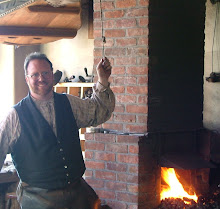Irving traveled with some fellow land speculators from Albany up the lightly settled Mohawk valley. They then traveled overland from near Utica to the headwaters of the Black River. Then they followed the Black River Valley north, as there was no road yet north of Rome. At the village of High Falls (now called Lyons Falls, N.Y.) he boarded a scow that carried him north with the river current. In two days he and his companions had traveled 42 miles, and disembarked at the hamlet of Long Falls (now called Carthage, N.Y.) Still 60 miles of travel from his destination, they sought lodging in the only Public House in the village.
To say that Irving was unimpressed with his accommodations on the frontier would be an understatement. He dubbed the Inn by the title, “The Temple of Dirt”. Upon leaving he scribbled this on the plaster over the fireplace mantle,
“Here Sovereign Dirt erects her Sable throne,Some years later, Judge William Cooper was also traveling through Long Falls, and stayed in the same Public House. Cooper was, himself, the namesake and founder of the town of Cooperstown, and no stranger to the conditions of the frontier. He penned a reply to Irving’s complaints on the same wall. He wrote,
The house, the host, the hostess are all her own.”
“Learn hence, young man, and teach it to your sons,There you have it, Northern New York’s first Poetry Slam! Washington Irving went on to become famous for his stories like Sleepy Hollow and Rip Van Winkle. Judge Cooper became a prosperous and influential figure in N.Y. His son James Fennimore Cooper would also become a famous author, known for his Leatherstocking Tales featuring adventures on the New York State frontier.
The wisest way is to take it as it comes.”












